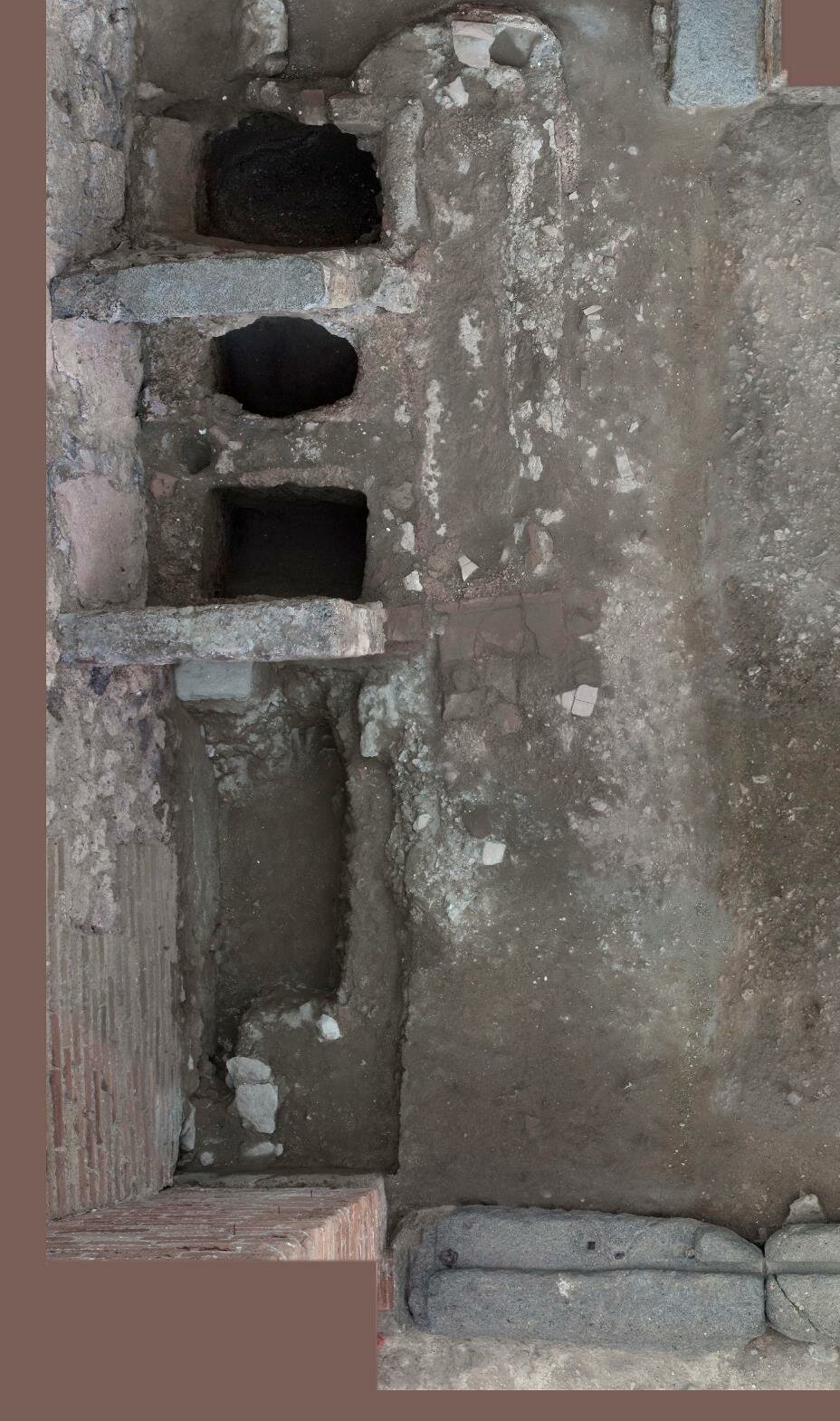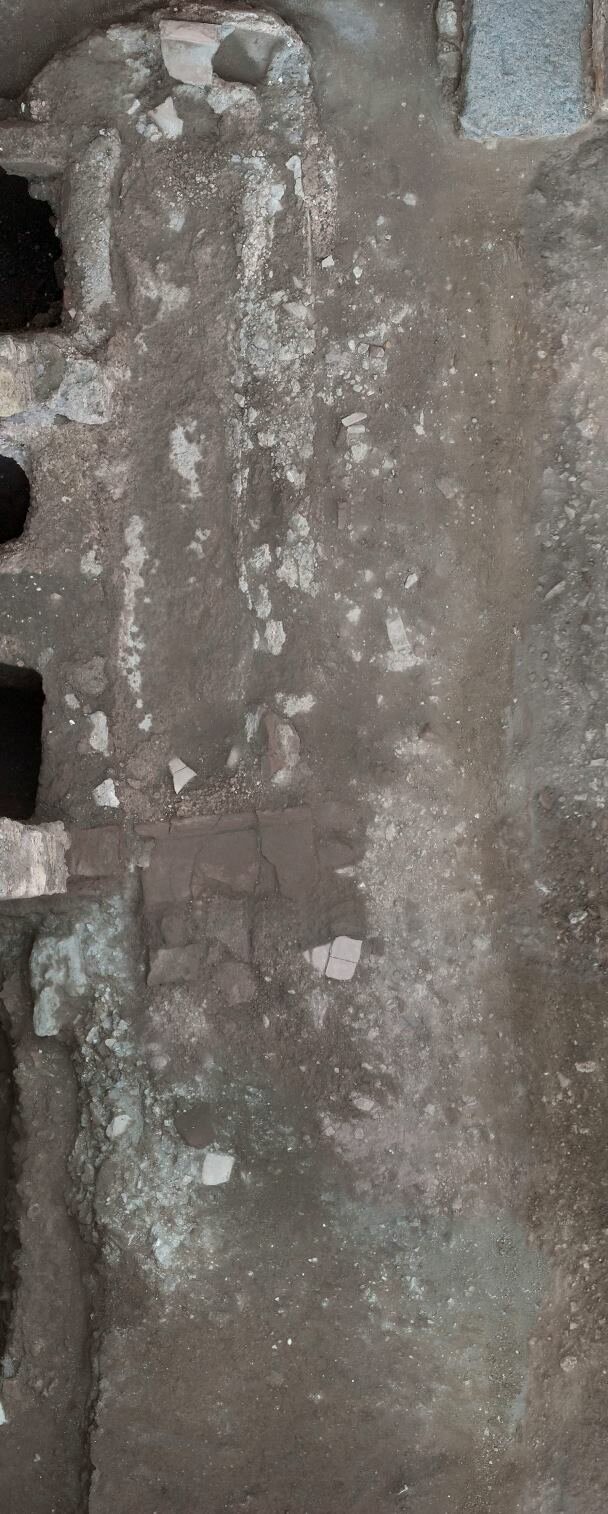Installations in floor
Description
Susanna Blåndman
Installations for the fulling activity in the room:
Supporting walls
Two supporting walls are located along the west wall of room 3, at a distance of 2.00 m and 3.32 m from the south corner. Between the two supporting walls two fulling stalls are located and a third stall is located north of the north supporting wall. At a distance of 0.67 m north of the south supporting wall the remains of the third wall, now lost, abuts on the wall plaster of the west wall. Only the lowermost part of the south supporting wall is original. The same is true for the north supporting wall, only the lowest part is original. Due to the rather scarce remains it is however clear that the original wall was 0.05 - 0.06 m longer than today. Wall plaster above the north wall indicates that the original height was approximately the same as today.
Fulling stalls
There are three fulling stalls in room 3 that abut on the west wall at a distance of 2.22 m; 2.88 m and 3.50 m from the south corner. The upper rim of the stalls is located only slightly higher than the floor level and the depth of the stalls varies from 0.35 m to at least 0.63 m.
The south fulling stall
This stall is rectangular in shape and the depth of the stall is 0.42 m. The rim on all the sides except the east side is made of cocciopesto and they are heavily worn in some places. The east rim is made of greyish mortar. All four inner sides of the stall are made of filling material, consisting of firmly packed stones, fragments of roof tiles and soil. The bottom is concave and made of greyish mortar.
The central fulling stall
The central stall is oval in shape and the depth of the stall is 0.35 m. The stall is 0.04 - 0.06 m wider beneath the rims. The rims are badly worn but fragments of the cocciopesto surface still remain along all four rims. The stall was cleaned to the bottom, which was made of greyish mortar. The bottom of the stall is concave and all four inner sides of the stall are made of filling material, consisting of firmly packed stones, fragments of roof tiles and soil. A conical hole is located between the central and the south stalls. The hole is 0.18 m deep and 0.14 m wide at the top.
The north fulling stall
This stall is rectangular in shape and the excavated depth of the stall is 0.43 m. The inner walls of the stall consisted of soil and stones and they were extremely fragile. Due to this we did not clean the stall to its bottom and it is at least 0.20 m deeper than the excavated depth. To the east there was a layer of lapilli directly under the rim, meaning that at least this stall was open during the eruption. We were not able to remove it since the area was too fragile. The south and the west rims are made of cocciopesto and the south rim is damaged in the top and in the bottom. It is to some extent covered by modern mortar. The east and north rims are heavily worn and only greyish mortar and fragments of roof tiles remain.
Work floor
On the east side of the basins there is a oblong work floor with a slightly higher surface than the surrounding floor and with a rim on all sides except to the west where the rim against the basins is indistinct. The rim of the feature is 0.16 m thick and the surface inside it is 0.06 cm deeper than the rim. It seems to abut on the rim of the central basin, but no conclusions can be made concerning the south and the north basins. To the east, the layer of filling material abuts on the elevated floor surface.
The surface inside the feature is concave. The rim seems to be made of mortar and stones but it is heavily worn and no certain conclusions can be made concerning the surface. In the south end there is a now broken roof tile, which makes a distinct and straight end. The north end is curved. Spolia of roof tiles have been used in the north, of which only one fragment remains together with an impression of yet another fragment. In the northeast part of the rim there are two lines of hydraulic plaster that join together in the north, most probably traces of an earlier phase . This was also observed by Flohr (2011, 3). The area between these lines is heavily worn and consists of Sarno stones, soil and mortar. The inner surface of the floor is made of cocciopesto and it is quite well preserved in the central part. The south part contains four spolia of terracotta, of which two are part of the east rim. A few patches of cocciopesto floor are located close to the elevated floor surface. Due to the constant humidity it was not possibly to see the colour of the mortar in the feature.
Lava blocks
A rectangular block is situated in the filling material at a distance of 2.83 m from the east wall of room 3 and 0.01 - 0.02 m from the north wall of room 3. Only the upper flat surface is visible.
A smaller lava block is located along the west wall at a distance of 1.84 m from the south corner of the wall. It has a flat surface and is 0.10 m thick. It is placed in the filling layer and was not visible until we started a small-scale excavation in this part of the room. The function of the blocks remains unclear.
South supporting wall:
H: 0.68 - 0.73 m. L: 0.83 m. 0.16 m wide
North supporting wall:
H: 0.49 - 0.54 m. L: 0.80 m. 0.17 m wide.
South fulling stall:
L: incl. rim: 0.95 m (N); 0.94 m (S); 0.54 m (W) and 0.51 m (E)
L: excl. rim: 0.61 m (N); 0.62 m (S); 0.44 m (W) and 0.39 m (E)
Elevations:
Bottom of rim: 32.44 m.a.s.l
Bottom of basin: 32.02 m.a.s.l.
Central fulling stall:
L: incl. rim: 0.96 m (N); 0.96 m (S); 0.50 m (W) and 0.40 m (E)
L: excl. rim: 0.50 m (N); 0.50 m (S); 0.18 m (W) and 0.20 m (E)
Elevations:
Bottom of rim: 32.45 m.a.s.l.
Bottom of basin: 32.10 m.a.s.l.
North fulling stall:
L: incl. rim: 1.04 m (N); 1.00 m (S); 0.50 m (W) and 0.60 m (E)
L: excl. rim: 0.76 m (N); 0.80 m (S); 0.50 m (W) and 0.46 m (E)
Elevations:
Bottom of rim: 32.42 m.a.s.l.
Bottom of basin: 31.99 m.a.s.l.
Work floor:
L: 2.20 m incl. rim and 2.04 m excl. rim (N - S)
Wi: 0.54 - 0.60 m incl. rim and 0.30 - 0.32 m excl. rim (W - E)
Elevations:
Rim: 32.49 m.a.s.l
Surface inner part: 32.43 m.a.s.l.
Lava blocks
Close to north wall: L.: 0.36 m (N); 0.34 m (S); 0.28 m (W) and 0.27 m (E)
Elevation: 32.37 m.a.s.l.
Close to west wall: L.: 0.32 m (N); 0.28 m (S); 0.20 m (W) and 0.16 m (E)
Elevation: 32.37 m.a.s.l.


